
According to the Japanese transport authority's test results, certain diesel-powered vehicles in the country produce higher emissions during on-road driving compared with laboratory conditions, reports the Wall Street Journal. The ministry conducted tests on six types of diesel vehicles and found that four models, manufactured by Japanese automakers, emitted up to 10 times more nitrogen oxide (NOx) than the standards set for laboratory testing. No illegal software was found in any of the tested cars. Due to the absence of any field-test regulations in Japan, the automakers have not violated any law. In light of the test results, the Ministry of Land, Infrastructure, Transport, and Tourism (MLIT) is now considering setting up on-road emission standards, adds the report. The models with the biggest emissions gaps were certain versions of the Toyota Hiace van and Land Cruiser Prado sport utility vehicle (SUV), the Nissan X-Trail SUV, and the Mitsubishi Delica D:5, all sold in Japan. On the other hand, Mazda's CX-5 and Demio yielded almost the same emissions results as in the laboratory tests. According to the MLIT, the emissions gaps in the Toyota and Nissan vehicles most likely emerged during field testing as cold weather prompted the vehicles to activate an engine protection mechanism whereby the vehicles switch off the exhaust gas recirculation system, which reduces NOx formation, for a set period of time.
Significance: Currently, Japan is engaged with the European/global move (excluding the US) to standardise emissions testing across major markets and bring them closer to real-world driving emissions via the World harmonised Light-vehicle Test Procedure (WLTP). However, with widespread adoption not expected until 2020, in markets such as the European Union the move to achieve emissions testing closer to real-world conditions is being ushered in prior to the WLTP via the Real Driving Emissions (RDE) programme, which is being adopted voluntarily prior to enforcement. Japan's diesel-engine emissions legislation, although stringent, involves only laboratory tests and there is no transition model in place before the introduction of the WLTP. The news today, which frankly would have come as no surprise to either the MLIT or the carmakers, does, however, appear to indicate that there is now the political will to adopt some sort of transition strategy prior to the WLTP's adoption.








